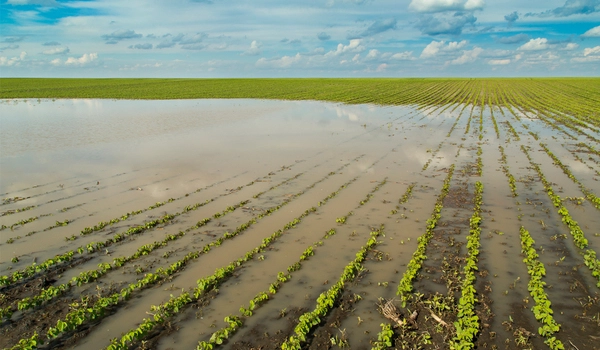Researchers demonstrate which signaling pathways help plants resist flooding. The molecule ethylene alerts plants when they are submerged in water and activates the emergency supply for survival in the absence of oxygen. When plants are pretreated with ethylene, they can survive without oxygen for longer periods of time.
Flooding occurs when there is heavy rain and the ground cannot drain the water quickly enough. Most plants can withstand short-term flooding (unless it is a severe torrential flood that washes away everything in its path), but long-term flooding can cause significant crop damage. Floods are becoming more common or severe in many areas. It is important that crops are protected from flooding, particularly in areas which are vulnerable to flooding.
Extreme weather events, such as droughts and wildfires, are becoming more common around the world. Floods are another obvious result of climate change. Flooding causes significant crop losses in agriculture, accounting for approximately 15% of global crop losses. Junior Professor Dr. Sjon Hartman from the Cluster of Excellence CIBSS — Centre for Integrative Biological Signalling Studies at the University of Freiburg has discovered that a signaling molecule can make plants more resistant to flooding as part of a collaboration between Freiburg, Utrecht in the Netherlands, and other institutes. Ethylene, a gaseous plant hormone, causes the plant to activate a molecular emergency power system that allows it to survive the lack of oxygen during flooding.
Taken together, these ethylene-induced plant rearrangements improve plant survival during and after flooding. As we gain a better understanding of these signaling pathways, we will be able to learn how to make crops more resilient to flooding in order to combat climate change.
Dr. Sjon Hartman
Previously, the team demonstrated that ethylene signals to the plant that it is underwater. The hormone treatment improved the survival chances of the experimental plants. The findings, published in the journal Plant Physiology, should aid in the fight against waterlogging and flooding in agriculture, as well as the development of resistant plant varieties.
Plants care about their stature. Short crops can carry more grain without bending under their own weight, which was a key factor in the 1960s Green Revolution. Tall plants, on the other hand, fare better in long floods. Researchers have discovered two genes that work together to control the height of rice plants: one that accelerates stem elongation and the other that acts as a brake. If the system is similar in other plants, scientists say it could be useful in the breeding of many kinds of crops.

Tracking the adaptations to wet conditions
Plant species differ greatly in their ability to withstand flooding or waterlogging. “In the case of potatoes, the roots die after two days due to a lack of oxygen. Rice plants are much more resistant, surviving their entire lives in flooded paddy fields “Hartman explains. Arabidopsis thaliana, a model organism for plant research, can be used to study the genes and proteins involved in this adaptation. “Plants notice that they are surrounded by water because the gas ethylene, which all plant cells produce, can no longer escape into the air,” Hartman continues. Previous studies at Utrecht University demonstrated this. Following that, receptors throughout the plant respond to increased hormone concentrations.
Simulate flooding with oxygen deprivation
Arabidopsis seedlings were placed in a bell jar without light or oxygen to simulate flooding. The root tip cells survived longer when the seedlings were previously exposed to ethylene gas. The treated plants ceased root growth and shifted energy production in cells to oxygen-free metabolic processes. Furthermore, the ethylene made the cells more resistant to the harmful oxygen radicals that accumulate in oxygen-depleted plants. Analyses of gene activity and protein composition in cells revealed this.
“Taken together, these ethylene-induced plant rearrangements improve plant survival during and after flooding,” Hartman concludes. “As we gain a better understanding of these signaling pathways, we will be able to learn how to make crops more resilient to flooding in order to combat climate change.”
















